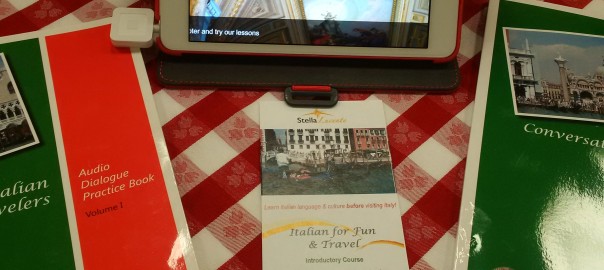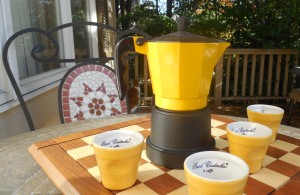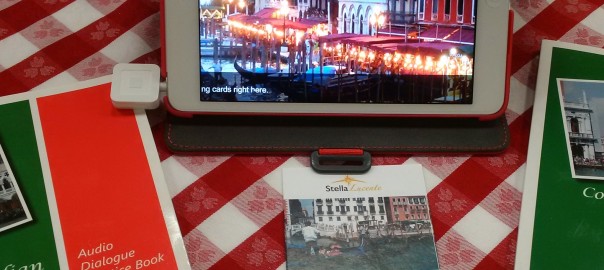Italian Dialogue Practice: Shopping in Italy
Use our Italian practice tips to go shopping in Italy! Listen to our Italian dialogue about two cousins in an Italian shop!
Italian Dialogue Practice: Shopping in Italy
Can you speak Italian? By now, many of you have passed the beginning stages of learning how to speak Italian and can read and comprehend quite a bit of the language. Meraviglioso!
But have you tried to take the next step to communicate in Italian fluently? Are you familiar with the vocabulary to use when shopping in Italy?
Our Italian Practice blog Shopping in Italy includes an audio dialogue recorded with native Italian speakers! In our Italian Subjunctive Mood Dialogues, we have been introduced to the story of Caterina and Francesca, two Italian cousins who are living in different cities and trying to reconnect . In the dialogue for this blog, Caterina visits Francesca in Rome, and they go shopping to buy Caterina some new clothes.
Click on the “PLAY” button below and listen to the Italian dialogue from our Conversational Italian for Travelers text book, “Chapter 10 – Shopping in Milan,” right on this blog. Read along on the printed page that follows the dialogue button. Afterward, click on the website link www.LearnTravelItalian.com and interact with the same recorded audio on our website. Listen to individual lines over and over again—as many times as needed!
After the dialogue, we will present information about how to use Italian reflexive verbs to refer to dressing oneself and trying on clothes. We will also describe how to use questo and quello to point out to the shopkeeper which of those wonderful Italian items will make the perfect souvenir to remember a trip to Italy!
This material is adapted from our textbook, Conversational Italian for Travelers © 2012 by Stella Lucente, LLC, found on www.learntravelitalian.com.
Italian Dialogue Practice: Shopping in Italy
Italian Dialogue: Chapter 10: Shopping in Milan
| Francesca | Caterina, abbiamo
molto da fare oggi. |
Kathy, (we) have
a lot to do today. |
| È giovedì, e il giovedì
io vado a fare la spesa. |
(It) is Thursday, and on Thursdays
I go to do the grocery shopping. |
|
| E poi, la mia amica Anna
ci invita a prendere un caffé in un bar. |
And then my friend Ann
invites us to (take) have coffee in a bar. |
|
| Ti piace fare la spesa? | (Do) you like to do the grocery shopping?
(lit. Is it pleasing to you…?) |
|
| Caterina | Si, mi piace fare la spesa
al supermercato.
|
Yes, I like to do the grocery shopping at the supermarket.
|
| Ma, mi piace di più
andare a comprare vestiti. |
But, I like more
to go to buy clothes. (lit. It is pleasing to me more…) |
|
| Ho bisogno di
un vestito nuovo e vorrei comprare anche qualcosa per mia sorella in America. |
(I) need
a new dress and also (I) would like to buy something for my sister in America. |
|
| Francesca | Molto bene.
Andiamo a fare shopping! |
Very well.
Let’s go shopping (for clothes)! |
| Ci sono molti bei negozi a Milano. | There are many nice shops in
Milan. |
|
| Francesca | (Dopo un po’…
Francesca e Caterina entrano in un negozio di vestiti e incontrano la commessa Laura.) |
(After awhile…
Frances and Kathy enter a dress shop and meet the salesgirl Laura.) |
| Laura
(a Caterina): |
Buon giorno.
Posso aiutarla? |
Good day.
May (I) help you? (polite greeting to a customer) |
| Caterina | Cerco un vestito da sera,
carino ma elegante. |
(I) am look(ing) for an evening dress,
cute, but elegant. |
| Mi piace molto ballare.
Avete vestiti neri? |
I like dancing very much.
(lit. Dancing to me is pleasing…) (Do) you all have black dresses? (plural (voi) form of “you” used to address salespeople politely) |
|
| Laura | Certamente.
Che taglia porta? |
Certainly.
What size (do) you take? (polite question) |
| Caterina | Porto la (taglia) quarantasei. | (I) take (the) size 46 (Italian). |
| Laura | Questo vestito è alla moda. | This dress is in style. |
| Caterina | Francesca, ti piace? | Frances, (do) you like (it)?
(lit. Is it pleasing to you…?) |
| Francesca | Si, ma anche questo (vestito) e bello. Provali tutti e due. | Yes, but also this (dress)
is nice. Try them both on. |
| Caterina
(a Laura): |
Avete taglie più grande? | (Do) you all have larger sizes?
(plural (voi) form of “you” used to address salespeople politely) |
| Mia sorella porta la (taglia) quarantotto. | My sister takes (the) size
48 (Italian). |
|
| Laura | Si, questo, o forse quel vestito. | Yes, this, or maybe that dress. |
| Francesca | Caterina, ti piace questa gonna per tua sorella? | Kathy, (do) you like this
skirt for your sister? (lit. Is this skirt pleasing to you…?) |
| Caterina | È bella, ma
a mia sorella non piace il colore marrone. |
(It) is nice, but
my sister doesn’t like the color brown. (lit. To my sister, the color brown is not pleasing…) |
| Francesca | E quella (gonna)? | And that one (skirt)? |
| Caterina | Oh, quella (gonna) è perfetta.
Le piace di più il rosso del marrone. |
Oh, that (skirt) is perfect.
She likes red more than brown. (lit. To her, red is more pleasing than brown.) |
| La prendo! | I’ll take it! | |
| Caterina
(a Laura): |
Dov’è posso trovare
il camerino? |
Where can (I) find
the fitting room? |
| Laura | Eccolo. | Here it is. |
| Francesca | (Dopo pochi minuti…) | (After a few minutes…) |
| Caterina | Allora, Francesca.
Mi metto il vestito. |
Now, Frances.
I put on (myself) the dress. |
| Che pensi?
Mi sta bene? |
What (do you) think?
(Does it) look good on me? (lit. Does it stay well on me?) |
|
| Francesca | Ti sta benissimo!
Ma com’è l’altro? |
(It) looks wonderful on you!
But how (about) the other? |
| Caterina | L’altro non mi va bene.
È troppo stretto. |
The other did not fit me well.
(idiomatic expression) (It) is too tight. |
| Laura
(a Caterina): |
Desidera altro? | (Do) (you) want anything else? |
| Caterina | No, mi piacciono questi (vestiti). | No, I like these (clothes).
(lit. These clothes are pleasing to me.) |
| Quanto costano questo vestito e questa gonna? | How much is (costs) this dress and this skirt? | |
| Laura | Sono cinquantadue euro per il vestito e ventitre euro per la gonna. | (They are) 52 euros for the dress and 23 euros for the skirt. |
| Caterina | Non c’è male. | That’s not too bad. |
| Laura | Ecco la cassa.
Come vuole pagare? |
Here is the cashier’s counter.
How (do) (you) want to pay? |
| Caterina | Posso pagare con un assegno? | Can (I) pay with a check? |
| Laura | Mi dispiace.
Non accettiamo assegni. |
I’m sorry.
(We) don’t accept checks. |
| Accettiamo la carta di credito o il bancomat. | (We) accept (a) credit card or (a) debit card. | |
| Caterina | Va bene. Pago in contanti. | Very well. (I will) pay in cash. |
| Mi può dare la ricevuta, per favore? | Can you give me the receipt, please? | |
| Laura | Ma, certo! Grazie mille! | But certainly! Thank you very much! |
Italian Dialogue Practice: What You Will Need to Know…
Italian Dialogue Practice: Shopping in Italy
For Italian Dialogue You Will Need to Know…
Expressions That Describe Shopping
Many important expressions describe the act of shopping in Italian. Notice from the tables below how the phrases differ depending on the type of shopping to be done. Examples follow.
Grocery Shopping
| fare la spesa | to do the grocery shopping
to do some grocery shopping |
General Shopping
| fare spese | to do the shopping (clothes, shoes, or other personal items) |
| fare compere | to do the shopping (any purchase) (la compera = purchase) |
| fare acquisti | to do the shopping (any purchase) (l’acquisto = purchase) |
| fare shopping | to do the shopping |
We have seen in the dialogue for this chapter that although Americans use the simple phrase “go shopping” for any shopping that they do, Italians often “go to do the shopping,” with the expression “andare a fare la spesa.” This interesting expression refers only to grocery shopping. A phrase denoting the location of the shopping, such as “al supermercato” (“at the supermarket”) can be used to complete the sentence. In most cases, both speakers know the place to obtain groceries, so the actual place is omitted.
If one is going to shop for non-grocery items, several phrases can be used. “Fare spese” is similar to the phrase we have just learned for grocery shopping, but it instead means “to go shopping for clothes, shoes, or other personal items,” usually in the piazza or shopping district in town known to the speakers. Two phrases can be used for shopping in general, for any purchase: “fare compere” and “fare acquisti.” A very popular phrase in Italy today that can be used for any type of shopping is simply “fare shopping!”
Otherwise, to shop for a specific item, use “andare a comprare” and mention what you are going to buy; for instance, complete this phrase with the word vestiti for clothes, like Caterina did in our dialogue.
| Faccio la spesa. | (I) do the (grocery) shopping. |
| Vado a fare la spesa. | (I) go to do the (grocery) shopping. |
| Vado a comprare… | (I) go to buy… (any item). |
| Faccio shopping. | (I) go (lit. do/make) shopping (general). |
| Faccio shopping di vestiti. | (I) go (lit. do/make) shopping for clothes. |
| Faccio compere. | (I) go (lit. do/make) shopping (general). |
| Faccio acquisti. | (I) make purchases (usually for non-grocery items). |
| Mi può mostrare… | Could you (pol.) show me… |
| Mi fa vedere… | Could you (pol.) show me… |
| Posso? | May I? |
| Che taglia porta? | What size do you (pol.) wear? |
| Porto la taglia…/Porto la… | (I) take the size…/(I) take the (size)… |
| Qual’è la taglia italiana per | What is the Italian size for |
| la taglia dieci americana? | (the) size 10 American? |
| alla moda/di moda | in style |
| di marca | designer/brand name |
| Mi provo…/Ti provi | (I) try on (myself)…/(You fam.) try on (yourself)… |
| Mi metto…/Ti metti… | (I) put on (myself)…/(You fam.) put on (yourself)… |
| Mi metto… | (I) am trying on (myself)…/(I) am going to try on (myself)… |
| Mi sta bene. | (It) looks good (lit. stays well) on me. |
| Ti sta bene. | (It) looks good (lit. stays well) on you. |
| Mi va bene. | (It) fits me well. |
| La/Lo prendo! | I’ll take it! (fem./masc. direct object) |
| Le/Li prendo! | I’ll take them! (fem./masc. plural direct object) |
Italian Dialogue Practice: Shopping in Italy
For Itlaian Dialogue You Will Need to Know…
Reflexive Verbs of Dressing Oneself
Italian uses the reflexive verb mettersi (to put on oneself) to convey the ideas of “I put on the dress,” “I put on my dress,” and “I put my dress on.” The reflexive pronoun mi (myself) is placed before the conjugated form of mettersi, as usual, and the article of clothing to be put on is then placed after the verb. The subject pronoun is omitted.
So when Caterina goes to try on her dress in our dialogue, she says, “Mi metto il vestito.” Just remember the simple phrase “mi metto,” and replace vestito with the article of clothing of your choice to describe your own action! To describe action in the tu (you) form, use “ti metti.”
| (Io) Mi metto il vestito. | I put on the dress./I put the dress on./I put on my dress. |
| (Tu) Ti metti l’anello. | You put on the ring. |
Also, remember that stare is used to describe how someone feels? Well, to tell someone “It looks good on you!” follow this simple method: Conjugate stare into the third person, or “it” form, sta, then place an indirect object pronoun before the verb.
This is easier than it sounds, because for routine conversational use of the io and tu forms, Italian words we already know—mi and ti—are again used. (Mi means both me and to me, and ti means both you and to you; the same Italian words are used for both direct and indirect object pronouns for the io and tu forms.)
So when Francesca told Caterina in our dialogue, “Ti sta bene,” she was saying, literally, “To you, it stays well,” with the meaning, “It looks good on you.”
To ask someone if an article of clothing you are wearing looks good, use, “Mi sta bene?” If clothing looks really wonderful on someone, reply, “Ti sta benissimo!”
| Mi sta bene? | Does it (article of clothing) look good on me? |
| Ti sta bene. | It looks good on you. |
| Ti sta benissimo! | It looks wonderful on you! |
Finally, the expression “va bene” that we have come to know so well by now is also used to describe how an article of clothing fits on a person. If it fits well, say, “Va bene.” If not, use “Non va bene,” as Caterina does in our dialogue to describe a dress that did not fit her properly.
Italian Dialogue Practice: Shopping in Italy
For Italian Dialogue You Will Need to Know…
How to Describe Wearing Clothes
with the Verbs Portare, Mettersi, and Vestire
In order to say “I am wearing…” or “I take the size…” the verb portare, which is not reflexive, is usually used in the present tense. You no doubt remember that portare is commonly used to mean “to bring” or “to carry.”
| Porto il mio vestito preferito. | I am wearing my favorite dress. |
| Porto la (taglia) quarantotto. | I take size 48. |
Portare can also be used to say “I wore” in the past tense. But perhaps because portare is used so commonly with its other meaning of “to bring” in the past tense, to describe what they wore, most Italians prefer to revert to mettersi and use its past participle messo. Here is how it works:
| (Io) Mi sono messo una gonna. | I wore a skirt. |
| Ho portato una gonna. | I wore a skirt. |
Another way to describe how someone was dressed, is to use the past tense verb “essere vestito(a,i,e).” This verb can be used to make generalizations, as well as to refer to a specific article of clothing. When being specific, the preposition “con” is used in these phrases, as in the examples below.
| Era vestito con un abito grigio. | He was dressed in a suit. |
| Era vestita con una gonna blu. | She was dressed in a blue skirt. |
| Eravamo vestiti tutto in rosso per la festa. | We were dressed all in red for the party. |
Italian Dialogue Practice: Shopping in Italy
For Italian Dialogue You Will Need to Know…
How to Describe Wearing Clothes
with the Verb Indossare
The verb indossare also means “to wear” and “to put on.” This verb can is used in exactly the same way as portare or mettersi. To the Italian ear, the verb indossare is said to have a more elegant sound than portare or mettersi, and perhaps this is why indossare is more common in written Italian than in conversation.
Just like the other two verbs that have the same meaning, indossare must always be followed by the article of clothing that the person is wearing.
| Caterina indossa un abito rosso. | Kathryn is wearing a red dress. |
| La signora indossava un cappotto molto elegantamente. | The lady was wearing a very elegant coat. |
******************************
Finally, when something fits perfectly on you or another, to really fit into Italian society, use the idiomatic expression “calzare a pennello.” Calzature refers to shoes, or “footwear,” so this Italian saying is the equivalent of the English saying, “It fits you like a glove” or “It fits you to a T.”
| Mi calza a pennello! | It fits me perfectly! |
| Ti calza a pennello! | It fits you perfectly! |
| Lo/la calza a pennello! | It fits him/her perfectly! |
Italian Dialogue Practice: Shopping in Italy
For Italian Dialogue You Will Need to Know…
Questa and Quella
The feminine demonstrative adjectives questa (this) and quella (that) have endings that follow our usual gender rules. Both have the usual –a ending for the feminine singular that changes to an –e ending in the plural, to make queste (these) and quelle (those).
It should be noted that if the singular feminine noun modified begins with a vowel, the usual –a ending of questa or quella can be dropped. The adjective and noun are then combined with an apostrophe to make conversation flow more smoothly.
Unfortunately, there is no hard-and-fast rule for when to drop the –a ending and when to keep it. As usual, listening to the language as it is spoken by a native is the best and most natural way to pick up these phrases. Here are a few examples:
Questa – This (Feminine)
Singular to Plural
| questa casa | this house | goes to | these houses | queste case |
| questa amica | this girlfriend | goes to | these girlfriends | queste amiche |
| quest’altra* | this other | goes to | these other | queste altre |
Quella – This (Feminine)
Singular to Plural
| quella casa | that house | goes to | those houses | quelle case |
| quella amica | that girlfriend | goes to | those girlfriends | quelle amiche |
| quell’altra* | that other | goes to | those other | quelle altre |
*In these last phrases, questo and quello are not followed by a noun, and so they are technically pronouns rather than adjectives… don’t worry about these different labels now, though.
Italian Dialogue Practice: Shopping in Italy
For Italian Dialogue You Will Need to Know…
Questo and Quello
The masculine demonstrative adjective questo (this) uses the usual –o ending for the masculine singular, which changes to an –i ending for the masculine plural and becomes questi (these).
Notice that if the singular masculine noun to be modified begins with a vowel, the usual –o ending of questo will be dropped and the words combined with an apostrophe to make conversation flow more smoothly.
Questo – This (Masculine)
Singular to Plural
| questo giorno | this day | goes to | these days | questi giorni |
| quest’amico | this friend (male) | goes to | these friends (male) | questi amici |
Quello – This (Masculine)
Singular to Plural
The masculine demonstrative adjective quello (that) does not follow our usual gender rules but instead follows the rules for the masculine definite article “the” when it precedes a noun.
The word quello itself follows the rule for the definite article lo and is only used before the singular form of Italian masculine nouns that begin with s + consonant, z, ps, gn, or pn. This is similar to another adjective that ends in -lo, bello.
Quel (that) is used to modify all singular masculine nouns that begin with a consonant, except for those noted in the last paragraph.
An apostrophe and an additional letter –l are added, to make quell’ (that) for singular masculine nouns that begin with a vowel.
For the plural masculine forms of quello, the usual –i ending is used for plural masculine nouns that begin with a consonant, to make quei (those).
The word quegli (those) is used for plural masculine nouns that begin with s + consonant, z, ps, gn, or pn, and all vowels…
This is not as complicated as it seems, because again, we are following the same rules as for the masculine definite article. The summary table is below:
Quello – This (Masculine)
Singular to Plural
| quel giorno | that day | goes to | those days | quei giorni |
| quell’amico | that friend | goes to | those friends | quegli amici |
| quello zio | that uncle | goes to | those uncles | quegli zii |
The above material is adapted from “Chapter 10 – Shopping in Milan” of the Conversational Italian for Travelers textbook, © 2012 by Kathryn Occhipinti, courtesy of Stella Lucente, LLC.
Kathryn Occhipinti, MD, is the author of the
Conversational Italian for Travelers series of books and a teacher of Italian for travelers to Italy in the Peoria and Chicago area.
“Everything you need to know to enjoy your visit to Italy!”
Join my Conversational Italian! Facebook group and follow me on Twitter at StellaLucente@travelitalian1 and start to learn Italian today for FREE!
Conversational Italian! Facebook Group
Tweet @travelitalian1 for Stella Lucente Italian
YouTube videos to learn Italian are available from © Stella Lucente, LLC.
Learn Conversational Italian.
More information on and photographs of Italy can be found on Facebook Stella Lucente Italian and Pinterest Stella Lucente Italian.
Facebook Stella Lucente Italian
Pinterest Stella Lucente Italian
Visit learntravelitalian.com/download.html to purchase/download Conversational Italian for Travelers and find more interesting facts and helpful hints about getting around Italy! Learn how to buy train tickets online, how to make international and local telephone calls, and how to decipher Italian coffee names and restaurant menus, all while gaining the basic understanding of Italian that you will need to know to communicate easily and effectively while in Italy. —From the staff at Stella Lucente, LLC
Italian Dialogue Practice: Shopping in Italy









